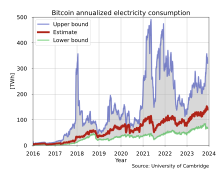Proof of work
[2][3] The concept was adapted to digital tokens by Hal Finney in 2004 through the idea of "reusable proof of work" using the 160-bit secure hash algorithm 1 (SHA-1).[5] A key feature of proof-of-work schemes is their asymmetry: the work – the computation – must be moderately hard (yet feasible) on the prover or requester side but easy to check for the verifier or service provider.[6][7] The purpose of proof-of-work algorithms is not proving that certain work was carried out or that a computational puzzle was "solved", but deterring manipulation of data by establishing large energy and hardware-control requirements to be able to do so.Hashcash's system was based on the concept of finding a hash value that met certain criteria, a task that required computational effort and thus served as a "proof of work."Here is a list of known proof-of-work functions: At the IACR conference Crypto 2022 researchers presented a paper describing Ofelimos, a blockchain protocol with a consensus mechanism based on "proof of useful work" (PoUW).Rather than miners consuming energy in solving complex, but essentially useless, puzzles to validate transactions, Ofelimos achieves consensus while simultaneously providing a decentralized optimization problem solver.But in bitcoin, double-spend protection is provided by a decentralized P2P protocol for tracking transfers of coins, rather than the hardware trusted computing function used by RPoW.[31] Some PoWs claim to be ASIC-resistant,[32] i.e. to limit the efficiency gain that an ASIC can have over commodity hardware, like a GPU, to be well under an order of magnitude.[35] In November 2022 the state of New York enacted a two-year moratorium on cryptocurrency mining that does not completely use renewable energy as a power source for two years.
cryptographicHashcashMoni NaorCynthia Dworkdenial-of-service attacksMarkus JakobssonHal FinneyBitcoinconsensusproof of stakeSybil deterrence mechanismscryptocurrenciesclient puzzleincentivealgorithmsAdam Backspamminge-mailrectangular distributionPoisson distributionwhich greatly varies in timeInteger square root moduloFiat–ShamirDiffie-HellmanMerkle treeGuided tour puzzle protocolconsensus mechanismoptimization problem solverWalkSATPeer-to-peerUniversity of CambridgeSwitzerland51% attackmining poolsapplication-specific integrated circuitsEnvironmental impact of bitcoinbitcoin blockchainEuropean Securities and Markets AuthorityNew Yorkrenewable energygrandfatheredBitmessageCryptocurrencyProof of authorityProof of burnProof of personhoodProof of spaceProof of elapsed timeConsensus (computer science)Dwork, CynthiaNaor, MoniEuropean ParliamentThe Washington PostBloomberg NewsAbadi, MartínGoldberg, AndrewCiteSeerXFranklin, Matthew K.Malkhi, DahliaFelten, Edward W.Wayback Machinebit goldHistoryEconomicsPoliticsLegal statusEnvironmental effectsGavin AndresenAndreas AntonopoulosBrian ArmstrongWences CasaresTim DraperWei DaiMark KarpelèsSatoshi NakamotoCharlie ShremNick SzaboVitalik ButerinRoss UlbrichtRoger VerCody WilsonCameron WinklevossTyler WinklevossCraig WrightDave KleimanJihan WuErik VoorheesList of bitcoin companiesList of bitcoin forksList of bitcoin organizationsList of people in blockchain technologyBitcoin networkBlockchainCryptocurrency walletBitcoin ATMLightning NetworkSegWitBitcoin UnlimitedBitcoin CashBitcoin GoldBitcoin scalability problemHistory of bitcoin2013 Bitcoin buried in Newport landfill2018 cryptocurrency crash2018 Bitcoin bomb threats2020 Twitter account hijackingThe Rise and Rise of BitcoinDeep WebBitcoin FoundationBitcoin MagazineBitmainCanaan CreativeCoinDeskGHash.ioBitcoin in El SalvadorBitcoin LawBitcoin BeachBitcoin CityCryptocurrency tumblerCryptographic hash functionDecentralized financeDistributed ledgerMetaMaskNon-fungible tokenSmart contractSHA-256


